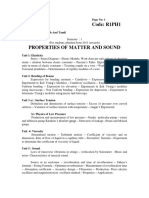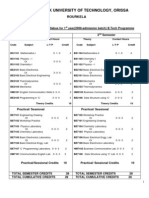Unit 1
Unit 1
Uploaded by
kick singhCopyright:
Available Formats
Unit 1
Unit 1
Uploaded by
kick singhOriginal Description:
Original Title
Copyright
Available Formats
Share this document
Did you find this document useful?
Is this content inappropriate?
Copyright:
Available Formats
Unit 1
Unit 1
Uploaded by
kick singhCopyright:
Available Formats
CLUSTER UNIVERSITY OF JAMMU
SYLLABUS – SEMESTER 4TH (CBCS) – B.SC PHYSICS
(CORE COURSE)
(EXAMINATION TO BE HELD IN 2017, 2018 AND 2019)
TITLE: WAVES AND OPTICS
COURSE CODE : 1PHYTC0401 CREDITS : 04
DURATION OF EXAMINATION TOTAL: 100 Marks
MINOR TEST : 01 Hour MINOR TEST: 20 Marks
MAJOR TEST : 2.5 Hours MAJOR TEST: 80 Marks
Objective: The course aims at enhancing the knowledge and understanding of students in the
areas of waves and optics.
Unit-I : Wave Motion (12 HOURS)
Plane and spherical waves, Longitudinal and transverse waves, Plane progressive waves, Wave
equation in simple and differential form, General solution of wave equation , Velocity of transverse
waves in a string , Velocity of longitudinal waves in a fluid, Energy density and intensity of a
progressive wave, Phase and group velocity, water waves: ripple and gravity waves. Characteristic
impedance of a string, Reflection and transmission coefficients, Impedance matching.
Unit-II : Superposition of Waves (12 HOURS)
Superposition principle and linearity, Superposition of two collinear harmonic oscillations with equal
frequencies and with slightly different frequencies (Beats), Superposition of two perpendicular
harmonic oscillations with equal frequencies and with different frequencies, Lissajous figures and
their uses, stationary/standing waves on a string of fixed length, eigen functions, energy of a
vibrating string, Melde’s experiment, Open and closed organ pipes.
Sound: Loudness of sound, Decibels, Intensity levels, Musical notes, Musical scale, Acoustics of
buildings: Reverberation , Absorption coefficient, Sabine formula, Measurement of reverberation
time, Acoustic aspects of halls and auditoria
Unit-III: Interference (12 HOURS)
Conditions for interference, Young’s double slit experiment, theory of interference fringes,
Fresnel’s biprism and its application to the determination of wavelength of sodium light, Phase
change on reflection , thin films (reflected and transmitted cases), Newton’s Rings: determination
of refractive index of liquid and wavelength of monochromatic light, Michelson’s interferometer
and its applications to determine (i) Wave length of monochromatic light (ii) thickness of thin
transparent plate (iii) resolution of spectral lines (iv) Determination of refractive index of glass.
COURSE CODE : 1PHYTC0401 Page | 1
CLUSTER UNIVERSITY OF JAMMU
SYLLABUS – SEMESTER 4TH (CBCS) – B.SC PHYSICS
(CORE COURSE)
Unit-IV: Diffraction (12 HOURS)
Fresnel’s diffraction , Fresnel’s half –period zones , rectilinear propagation of light , Zone plate
action of Zone plate , Diffraction at a straight edge , rectangular slit and thin wire, Fraunhofer
diffraction, single slit diffraction, two slit diffraction, plane transmission grating, determination of
wavelength of monochromatic light using grating, width of principal maximum, absent spectra,
dispersive power of grating, limit of resolution, Rayleigh’s criterion, resolving power of grating.
Unit-V: Polarisation (12 HOURS)
Polarisation by reflection, Brewster’s law, Malus Law, Phenomenon of double refraction, Huygen
theory of double refraction , Nicol prism, Quarter wave plate and half wave plate; theory,
Production and detection of plane, Circularly and elliptical polarized light, Optical activity,
Specific rotation, Laurent’s half shade polarimeter.
Reference Books:
1. Fundamentals of Optics, F A Jenkins and H E White, 1976, McGraw-Hill
2. Principles of Optics, B.K. Mathur, 1995, Gopal Printing
3. Fundamentals of Optics, H.R. Gulati and D.R. Khanna, 1991, R. Chand
Publication
4. University Physics. FW Sears, MW Zemansky and HD Young 13/e, 1986.
Addison-Wesley
5. Optics, Brij Lal, Subhramanyam and Avadhanulu, S.Chand and Co., New Delhi.
6. Optics, Ajoy Ghatak, Tata McGraw Hill.
7. Fundamentals of Optics, Devraj Singh, PHI Learning, New Delhi.
INSTRUCTIONS FOR PAPER SETTERS AND CANDIDATES:
1. The question paper for Semester End Examination will consist of two parts:
a) Part A will comprise of short answer /objective type questions of 16 marks (five
questions of 2 marks and six questions of 1 mark each) covering all five units.
b) Part B will comprise of eight questions of 16 marks each with two questions each from
II, III, IV and V units. The students will have to attempt four questions selecting one
question from each unit. Each question of 16 marks will have two parts: (i) long answer
question of 12 marks (ii) short answer question/numerical problem of 4 marks each. The
duration of the examination will be 2.5 hours.
2. The Minor Test will be held for unit I of the syllabus. It will comprise of two parts:
a) Part A consists of three long answer questions of 5 marks each and students will have to
attempt any two.
b) Part B consists of seven short answer questions of 2 marks each and students will have
to attempt any five.
COURSE CODE : 1PHYTC0401 Page | 2
You might also like
- Live To Tell The TaleDocument73 pagesLive To Tell The TaleYanquis Brownlee100% (1)
- Final Year Electrical Engineering Projects - NevonprojectsDocument5 pagesFinal Year Electrical Engineering Projects - Nevonprojectssharon kemigishaNo ratings yet
- OneForAll URC6012B ManualDocument1 pageOneForAll URC6012B Manualrob_techNo ratings yet
- Property Law NotesDocument82 pagesProperty Law NotesROHIT SINGH Rajput100% (1)
- Engineering and Technology, R.T.M. Nagpur University, Nagpur Syllabus For B.E. (Second Semester)Document19 pagesEngineering and Technology, R.T.M. Nagpur University, Nagpur Syllabus For B.E. (Second Semester)Anubhav SinghNo ratings yet
- Customer Presentation. Networth TelecomDocument14 pagesCustomer Presentation. Networth Telecomroman9khalenkovNo ratings yet
- Waves and OpticsDocument3 pagesWaves and OpticsRiyaNo ratings yet
- KahanDocument2 pagesKahanDebadrita BanerjeeNo ratings yet
- Syllabus Bsc Bed Only Physics-1Document25 pagesSyllabus Bsc Bed Only Physics-1tm9130877No ratings yet
- BPH-202 Waves & OpticsDocument2 pagesBPH-202 Waves & OpticsVijay KumarNo ratings yet
- BSC Syllabus at MWU 2012 - 5th SemesterDocument26 pagesBSC Syllabus at MWU 2012 - 5th SemesterKeshav PaudelNo ratings yet
- Syllabus PhysicsDocument20 pagesSyllabus Physicsgdckalyandurg svgmNo ratings yet
- Semester IV IPH-251 Physics-IV Geometrical and Wave Optics: Theory 4 Credits 3-1-0 Unit-IDocument12 pagesSemester IV IPH-251 Physics-IV Geometrical and Wave Optics: Theory 4 Credits 3-1-0 Unit-IRahul ChhimpaNo ratings yet
- Physics: Year: I Semester: IIDocument3 pagesPhysics: Year: I Semester: IIHercules ShahNo ratings yet
- NotsablosomDocument318 pagesNotsablosomசிவசங்கர் முத்துமல்லுNo ratings yet
- Final - Generic Elective - Physics Syllabus Sem-2 - Fundamentals of Physics-IIDocument6 pagesFinal - Generic Elective - Physics Syllabus Sem-2 - Fundamentals of Physics-IIVinayak SavarkarNo ratings yet
- Physics Honors Sem 4 Syllabus - Delhi UniversityDocument10 pagesPhysics Honors Sem 4 Syllabus - Delhi UniversityAstha YadavNo ratings yet
- Far Western University Faculty of Engineering: Specific Objectives Unit I: ElasticityDocument5 pagesFar Western University Faculty of Engineering: Specific Objectives Unit I: Elasticityसचिन खड्काNo ratings yet
- Draft Syllabus: Engineering PhysicsDocument4 pagesDraft Syllabus: Engineering PhysicsMartin Luther JrNo ratings yet
- Mlsu Physics 1 Paper SyllabusDocument7 pagesMlsu Physics 1 Paper SyllabusPavitra JhalaNo ratings yet
- 21 Phy 12Document4 pages21 Phy 12Sameer SNo ratings yet
- B.SC Physics 2016-17Document75 pagesB.SC Physics 2016-17Vinay NelasNo ratings yet
- Pplied Hysics-Ii: Vayu Education of IndiaDocument16 pagesPplied Hysics-Ii: Vayu Education of Indiagharib mahmoudNo ratings yet
- Phy 102 4 Physics 4 2 2Document4 pagesPhy 102 4 Physics 4 2 2Sagar AcharyaNo ratings yet
- Physics Syllabus (Sem-5)Document3 pagesPhysics Syllabus (Sem-5)tegevi9289No ratings yet
- Scheme & Syllabus 2017-18Document72 pagesScheme & Syllabus 2017-18Ritik GandhiNo ratings yet
- Physics SyllabusDocument16 pagesPhysics SyllabusReddyvari VenugopalNo ratings yet
- UG Physics 2015 2016Document40 pagesUG Physics 2015 2016rrtilakNo ratings yet
- GayaDocument2 pagesGayaDebadrita BanerjeeNo ratings yet
- Sem3 SyllabusDocument7 pagesSem3 SyllabusAnisha KhatriNo ratings yet
- Du MSC SEM 3 SyllabusDocument7 pagesDu MSC SEM 3 SyllabusVineet ChauhanNo ratings yet
- FE Phy IIDocument3 pagesFE Phy IIArun PillaiNo ratings yet
- Andhra Pradesh State Council of Higher EducationDocument34 pagesAndhra Pradesh State Council of Higher Educationsekhara2zNo ratings yet
- FE ECE 16 17 SyllabusDocument37 pagesFE ECE 16 17 SyllabusDr AjNo ratings yet
- B. Sc. Part - I Physics 2013 PDFDocument5 pagesB. Sc. Part - I Physics 2013 PDFRANDOLPHENo ratings yet
- Syllabus Sem 2Document23 pagesSyllabus Sem 2AnjaliTiwariNo ratings yet
- Andhra Pradesh State Council of Higher EducationDocument34 pagesAndhra Pradesh State Council of Higher EducationhareeshNo ratings yet
- Sem I (E Group) PDFDocument17 pagesSem I (E Group) PDFSunil GiriNo ratings yet
- LangauzeDocument2 pagesLangauzeSwapnil SinhaNo ratings yet
- Code: R1PH1: Page No: 1 Credits: 5 Hours/Week: 6 Medium: English and TamilDocument40 pagesCode: R1PH1: Page No: 1 Credits: 5 Hours/Week: 6 Medium: English and TamilHussain Mohammad ImranNo ratings yet
- OpticsDocument6 pagesOpticsDivyankur KainNo ratings yet
- B.SC 2nd and 3rd Year Syllabus SVUDocument16 pagesB.SC 2nd and 3rd Year Syllabus SVUSrinivasulu Pudu100% (1)
- FY Curriculm 2022-23 - 230327 - 132029Document38 pagesFY Curriculm 2022-23 - 230327 - 132029anishdeshmukh108No ratings yet
- AP 101 SyllabusDocument3 pagesAP 101 SyllabusTamandeep SinghNo ratings yet
- Semester - IIIDocument6 pagesSemester - IIIWaaiz MohammedNo ratings yet
- 832rev Syll PhyDocument3 pages832rev Syll PhyroupyarNo ratings yet
- Physics Syllabus Sem 4Document10 pagesPhysics Syllabus Sem 4LoveNo ratings yet
- Syll Btech. 1st Year New Syllabus FINAL 2008 BPUTDocument22 pagesSyll Btech. 1st Year New Syllabus FINAL 2008 BPUTkamalkantmbbsNo ratings yet
- B.Sc. Part - I: PhysicsDocument7 pagesB.Sc. Part - I: PhysicsL fNo ratings yet
- Lecture 00 - Course IntroductionDocument13 pagesLecture 00 - Course IntroductionRahul GuptaNo ratings yet
- Open Elective Courses OldDocument97 pagesOpen Elective Courses OldmohinikNo ratings yet
- Physics UGDocument42 pagesPhysics UGNurRahmanAfifNo ratings yet
- PHY 142 Course Outline Revised Nov 2014Document4 pagesPHY 142 Course Outline Revised Nov 2014Tishona JosephNo ratings yet
- Btech. 1st Year New Syllabus FINAL 2008 BPUTDocument22 pagesBtech. 1st Year New Syllabus FINAL 2008 BPUTRajesh KumarNo ratings yet
- PhotonicsDocument2 pagesPhotonicsunni93No ratings yet
- Syllabus IV SemDocument13 pagesSyllabus IV Semabhishek2216739No ratings yet
- Engineering Physics (Sc19102) Version 3Document7 pagesEngineering Physics (Sc19102) Version 3AbhishekNo ratings yet
- BASC Pulp and Paper Science Course Revised Syllabus 2012 13Document71 pagesBASC Pulp and Paper Science Course Revised Syllabus 2012 13Vivek Singh100% (2)
- Mohanlal Sukhadia University, UdaipurDocument3 pagesMohanlal Sukhadia University, UdaipurnarendragrNo ratings yet
- Laser Metrology in Fluid Mechanics: Granulometry, Temperature and Concentration MeasurementsFrom EverandLaser Metrology in Fluid Mechanics: Granulometry, Temperature and Concentration MeasurementsNo ratings yet
- Maxwell's Equations and the Principles of Electromagnetic PhenomenaFrom EverandMaxwell's Equations and the Principles of Electromagnetic PhenomenaNo ratings yet
- Guard - Me@lambton Summary 2022 Hindi 1695852149Document2 pagesGuard - Me@lambton Summary 2022 Hindi 1695852149kick singhNo ratings yet
- UG 2nd SemDocument3 pagesUG 2nd Semkick singhNo ratings yet
- A1-03 DSBSC GenerationDocument2 pagesA1-03 DSBSC Generationkick singhNo ratings yet
- A1-03 - DSBSC Generation PDFDocument14 pagesA1-03 - DSBSC Generation PDFkick singhNo ratings yet
- Cluster University of Jammu: (Examination To Be Held in 2017, 2018 and 2019) TitleDocument2 pagesCluster University of Jammu: (Examination To Be Held in 2017, 2018 and 2019) Titlekick singhNo ratings yet
- Cluster University of Jammu: (Examination To Be Held in 2017, 2018 and 2019) Title: Microprocessor and MicrocontrollerDocument2 pagesCluster University of Jammu: (Examination To Be Held in 2017, 2018 and 2019) Title: Microprocessor and Microcontrollerkick singhNo ratings yet
- The Top 15 Supply Chain Metrics & KPIs For Your DashboardsDocument19 pagesThe Top 15 Supply Chain Metrics & KPIs For Your DashboardsRam PowruNo ratings yet
- MEA24 Bounced Contacts ListDocument54 pagesMEA24 Bounced Contacts ListAmit chauhanNo ratings yet
- David Carr - The Fifth Meditation and Husserls CartesianismDocument23 pagesDavid Carr - The Fifth Meditation and Husserls CartesianismMarina LilásNo ratings yet
- CPCSUS5001A - Unit Assessment PackDocument84 pagesCPCSUS5001A - Unit Assessment PackDivya JoshiNo ratings yet
- 2015 PRACTICE NOTES 2 Withholding Tax17022015095605 PDFDocument18 pages2015 PRACTICE NOTES 2 Withholding Tax17022015095605 PDFtendaicrosby100% (1)
- Model S Alert Codes 20180607 en US - PDF RoomDocument108 pagesModel S Alert Codes 20180607 en US - PDF Roomv.oliynyk.vNo ratings yet
- RHE249 - Rheem Combined Brochure - 01 March 2019 WebDocument20 pagesRHE249 - Rheem Combined Brochure - 01 March 2019 WebJeromeNo ratings yet
- Alpine Calciplex Air Classifier ACP: Time For A New Classifier GenerationDocument4 pagesAlpine Calciplex Air Classifier ACP: Time For A New Classifier GenerationSwaminathan SNo ratings yet
- TNC ImpactsDocument2 pagesTNC ImpactsClara Soo100% (1)
- Fluktuasi Kurs Valuta Asing Di Beberapa Negara Asia TenggaraDocument22 pagesFluktuasi Kurs Valuta Asing Di Beberapa Negara Asia TenggaraRazji ReyhanNo ratings yet
- Kante v. Nike, Inc. - Document No. 2Document14 pagesKante v. Nike, Inc. - Document No. 2Justia.comNo ratings yet
- A Midsummer Night's DreamDocument13 pagesA Midsummer Night's DreamCristina IonitaNo ratings yet
- MBZ - DP Consultants ReportDocument17 pagesMBZ - DP Consultants Reportapi-236337064No ratings yet
- wf6000 Otdr+iolm 2019 - 20200316 - 204959231Document6 pageswf6000 Otdr+iolm 2019 - 20200316 - 204959231mvasquez2011No ratings yet
- Citycell-A Failure Story: Submitted ToDocument9 pagesCitycell-A Failure Story: Submitted Toashikur rahmanNo ratings yet
- Admissibility of Evidence Through Modern Devices in IslamicDocument10 pagesAdmissibility of Evidence Through Modern Devices in Islamicnabia lodhiNo ratings yet
- Mcneil Dissertation FellowshipsDocument8 pagesMcneil Dissertation FellowshipsPaperWritingServiceCheapAnnArbor100% (1)
- Possessive Singular PluralDocument2 pagesPossessive Singular Pluralminimi92111No ratings yet
- BG173072265-HRM Practices of PJL Study - 2019 Final DraftDocument100 pagesBG173072265-HRM Practices of PJL Study - 2019 Final DraftFaisal Rahman ShagorNo ratings yet
- AFB Test - 1Document4 pagesAFB Test - 1waste mailNo ratings yet
- Cartography PrinciplesDocument6 pagesCartography PrinciplesSonali DehuryNo ratings yet
- Reading With Jean-Luc Godard: MourletDocument3 pagesReading With Jean-Luc Godard: MourletTimothy BarnardNo ratings yet
- NAMA: Himatul Aliyah NIM: 1011903: 1. Checking Vital SignsDocument6 pagesNAMA: Himatul Aliyah NIM: 1011903: 1. Checking Vital SignsHimatul AliyahNo ratings yet
- Mentholatum Vs MangalimanDocument3 pagesMentholatum Vs MangalimanDel Rosario MarianNo ratings yet
- MCQ On Factories Act 1948Document81 pagesMCQ On Factories Act 1948Raja Chitturi100% (4)































































































